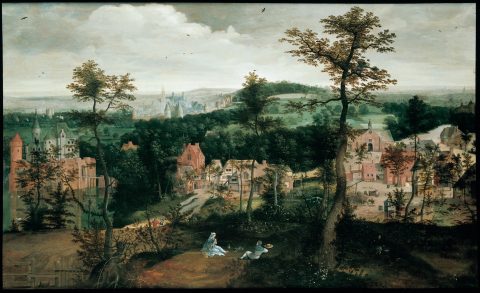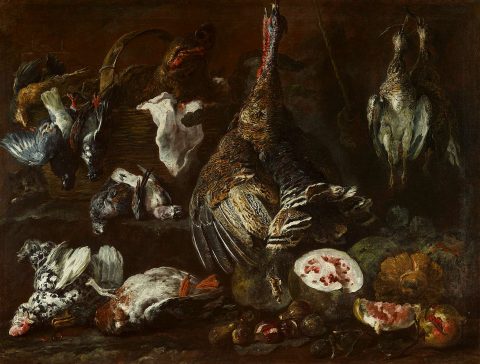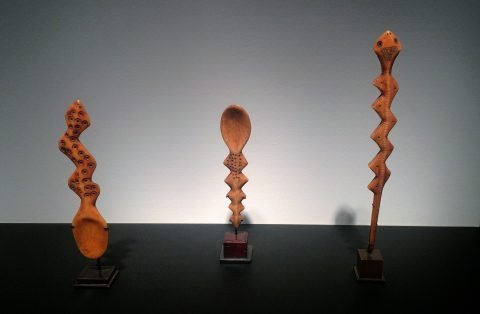Paris Tableau and BRUNEAF bet against contemporary art
Editions 2017 of Paris Tableau and The World Arts Fair/BRUNEAF aim to attract young contemporary art collectors. Will they take the opportunity to bring back the past to the present?
- Jacob Grimmer, The rest during the flight into Egypt; oil on canvas, 16th century. Courtesy Galerie De Jonckheere. At Paris Tableau 2017.
- Jan Fyt, Still life with birds, fruit, and a cat; oil on canvas, 17th century. Courtesy Galerie Canesso. At Paris Tableau 2017.
- Lega Statuette, D.R. Congo; ivory. Courtesy Galerie Didier Claes. At BRUNEAF 2017.
“The market for old masters is more accessible than the contemporary art market and this makes it attractive to a young clientele,” a spokesperson for the organisers of old master art fair Paris Tableau tells us. This young event, which started in 2011 in Paris as a consortium of local dealers – Galerie Eric Coatalem and Galerie Canesso among them – who were motivated to fill the lack of fairs specifically focusing on the old master market, has now landed in Brussels. On one hand, Paris Tableau clearly aims at attracting established Belgian collectors who otherwise would need to wait and travel to alternative events such as La Biennale Paris or Tefaf Maastricht, both nearby places but happening only late in the year or next winter. On the other hand, as the statement above shows, Paris Tableau is keeping an eye on the collectors of the future, stressing how old masters can be easily appreciated by young art lovers when compared to an otherwise complex market of contemporary art.
But regardless of the age of collectors, why has Paris Tableau chosen Brussels as its new home? As widely known, Belgium and Brussels don’t lack art lovers. They are a large part of an already “big family”, as Bertrand Gautier of Talabardon Gautier Gallery puts it, an international crowd of old master collectors who would feel the appeal of the city as the centre of Europe. A concept – Europe – that recent political events have made “trendy”, says Gautier, hence the move from Paris to Brussels.
Going back to old masters in general and their market, we wonder what makes them so accessible. Undeniably, some artworks on sale at Paris Tableau are true formal jewels, which easily makes them into highly desirable objects of aesthetic pleasure. For example, Galerie De Jonckheere presents “The rest during the flight into Egypt” by 16th Flemish master Jacob Grimmer, a landscape painting where the parsimony of colours – the greenish vegetation contrasting with the light red architectures – makes the whole composition exceptionally well balanced. Or the great “Still life with birds, fruit and a cat” by Baroque painter Jan Fyt on offer at Galerie Canesso, a picture in which the matter of the paint is intentionally left rather raw, departing from the maniacal attention to the details of most of his contemporaries still life painters to give a sense of concreteness to the subject.
As to the market, its accessibility might have to do with its stability. According to Gautier “the market of old masters has resisted the crisis we have been talking about for the past 10 years. Unlike the 90s crisis, this market has remained flourishing and its prices stable.” A similar take, even though about the market of traditional African art (which in many ways is a market of old masters) is the one by Didier Claes, a dealer who just moved his gallery space from the Sablon district to uptown Brussels, an area that is strategically positioned within the cluster of some of the biggest contemporary art galleries in town. Claes tells us: “The market for traditional African art is threefold. There is a high-end section that is just booming today, a steady market of mid-range priced artworks, and the low-end of the market, in which prices are decreasing. Nonetheless, this low-end part is increasing in size, with more new collectors approaching it every day. Most of these new collectors are particularly interested in the so-called ethnographic side of traditional African art.”
Galerie Didier Claes is one of the galleries specialising in non-Western traditional art that are included in The World Arts Fair/BRUNEAF, an event taking place these days in Brussels along with Paris Tableau. Structured as a circuit, The World Arts Fair/BRUNEAF presents traditional art coming from Africa, the East, and indigenous communities in both the Americas and Oceania, pieces that are on display across the most specialised galleries of Brussels as well as guest galleries from abroad taking over a few spaces in the Sablon district. For the occasion of The World Arts Fair/BRUNEAF, Galerie Didier Claes is presenting an exhibition of artworks by the Lega ethnic group from Eastern Congo—a collection of both anthropomorphic and zoomorphic statuettes whose prices range from 30k to 600k euros.
In conclusion, whether of Western or of non-Western old masters, the art market of antiques and its dealers we met in Brussels during these days of Paris Tableau and The World Arts Fair/BRUNEAF gives us the impression of being particularly interested in attracting young generations of collectors, more explicitly attempting to appeal to those who are already active in the contemporary art market but would be happily look elsewhere as well.
July 4, 2017



